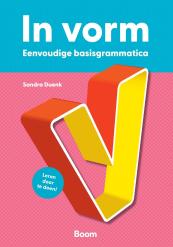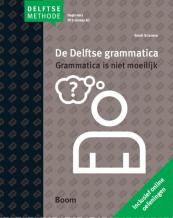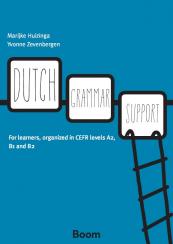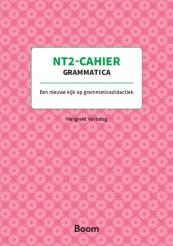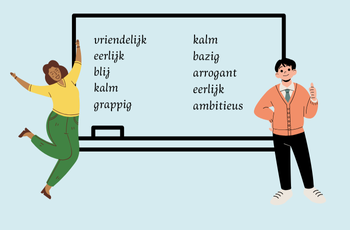Grammar in the NT2 classroom
Discussion about grammar in NT2 education
Within the discussion about grammar in NT2 education, roughly two approaches can be distinguished. On the one hand, there are the proponents of a more traditional approach, where the emphasis is on learning and memorizing grammar rules and making exercises. This group assumes that thorough mastery of grammar lays a solid foundation for language proficiency and is essential for producing correct language utterances.
In contrast, others argue that a communicative approach to teaching grammar is more effective. This approach focuses on using language in realistic situations, with an emphasis on developing language skills and promoting fluency. Proponents of this approach believe that grammar rules are best understood and learned when they are heard and applied in everyday situations.
Healthy balance
Although the debate between these approaches continues, the truth seems to lie somewhere in the middle. A healthy balance between grammar knowledge and communication skills, where grammar is a tool for understanding and producing language, but should not be the sole focus. It is important to place grammar rules in the context of real language use situations so that students can understand and apply the rules in meaningful contexts.
Getting started with grammar in the NT2 classroom
Whether grammar plays a small or large role in the NT2 lesson, for every type of teacher we have appropriate materials for grammar teaching. They offer support in the lessons. We give you 7 tips:
#1 Simple basic grammar
“Even the highest towers begin at the ground.” The book Simple Basic Grammar begins with this Chinese proverb . The author draws a parallel with learning a language: when you want to learn a language, you also have to start with a good foundation. From there you can build further. That is the purpose of Simple Basic Grammar.
With this book, beginning, hands-on learners learn the basics. The book starts with the basics and works from (grammatical) knowledge about letters, through to words, to phrases and finally to complete sentences. Simple Basic Grammar does not cover complicated grammatical topics such as the use of er.
#2 Clear Language!
Want to take grammar learning a step further? Then there's Klare taal! It covers a plethora of grammatical structures in 88 lessons, entirely in Dutch. In addition to the book, there is an online program, where students get explanations, can practice, get immediate feedback and check themselves with a test.
Teachers do not have to work linearly through Klare taal! and can pull exercises from the book or the online course as they see fit and in line with the lesson or topic. With instant feedback in the online program and answers in the back of the book, Klare taal! also lends itself well to self-study.
#3 In form
Grammar is doing! That was the starting point when developing In vorm. This book contains 33 chapters with a clear explanation of the grammar rule, after which you start working step by step with many different exercises and methods. In vorm is suitable for levels 0>A2 and can be used as a stand-alone method or in combination with another method.
#4 Dutch Grammar Support
Do you coach higher educated students who speak English? Then Dutch Grammar Support is highly recommended. Higher educated students in particular often feel the need for extra explanation of grammatical structures. Dutch Grammar Support provides this extra insight into the patterns, regularities and irregularities of Dutch.
These insights support the learning process and help students learn faster and better. The instructions in the book are simple and short. Complicated grammatical terms are avoided. This makes the book accessible to non-native speakers of English as well. Dutch Grammar Support covers grammatical structures that occur in everyday life and in work and study environments.
The grammatical structures are explained at levels A2, B1 and B2. This way students know exactly what they should know at which level. Dutch Grammar Support is designed for self-study, but teachers can also use it in class.
#5 The Delft Grammar
Yet another approach is that of The Delft Grammar. Here it assumes that Dutch grammar rules are actually relatively simple, but the trick is to present those rules in the right way. Unlike other grammars, De Delft grammar presents the rules in a natural and meaningful context. The grammatical rules are made understandable using examples from texts. The exercises then encourage the use of the grammatical patterns. Students thus learn Dutch grammar naturally.
#6 LINK Grammar trainer
In the popular NT2 method LINK, grammar is implicitly covered. In the separate Grammaticatrainer grammar is also offered explicitly. The structure of the Grammaticatrainer is different and more extensive than that of traditional grammar trainers.
In fact, each grammar topic begins with listening in order to properly notice the phenomenon at hand. This is followed by a practice series. Only at the end of the practice series is the grammatical rule offered, usually through a few clear examples and with minimal explanation in simple words. The grammar trainer works from receptive to productive. The extended practice sequences in the trainer incorporate only high-frequency words and as many functional sentences as possible, with the secondary goal of grinding them down.
Finally, the material is presented in small bite-sized chunks. The focus is particularly on speaking, and it is assumed that reading, listening and correct spelling will come along as more practice is given with frequent words and phrases.
#7 NT2 Cahier Grammar
Every NT2 teacher knows it, your student asks something about a certain grammatical phenomenon but actually you don't know the rule yourself. Sometimes you may not even know if there is a rule for it at all. Do you want to know how to explain and practice these kinds of grammar rules? Then it is useful to have the NT2 Cahier Grammar on your desk; a short and concise reference book with a brief explanation of the most common grammar rules.
#8 NT2 Language Game
Grammar doesn't always have to come from a book. With the NT2 Taalspel you get to work on sentence structure, word order and conjugating verbs. The game works as follows. There are three stacks of cards with verbs: regular, irregular and separable verbs.
In addition, there are six dice, which indicate how to construct a sentence. There are dice for such things as subject, tense, conjunctions and sentence type. You can differentiate well with this game, for example by using only the regular verbs or only the dice for subject and tense. Do you want the exercises to tie in with your lesson or theme? Then make a list of relevant words that students should use when forming the sentences.

